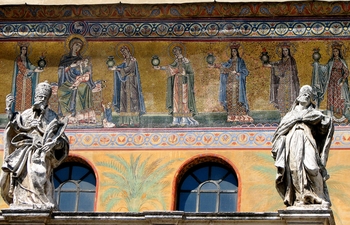I’ve often been impressed at the capacity of the Old African American Spirituals to treat of serious matters in a clear yet almost joyful way. This is true even of very serious concepts like sin and judgment. Look at some of the creative lines all from different spirituals:
I would not be a sinner, I’ll tell you the reason why. I’m afraid my Lord might call my name and I wouldn’t be ready to die.
Some go to Church for to sing and shout, before six months they’s all turned out!
Everybody talkin’ ’bout heaven aint a goin’ there, Oh my Lord!“
Where shall I be when the first Trumpet sounds, Oh where shall I be when it sounds so loud, when it sounds so loud as to wake up the dead, Oh where shall be when it sounds. How will it be with my poor soul, Oh Where Shall I be?
Better watch my brother how you walk on the cross! Your foot might slip and your soul get lost!
God gave Noah the rainbow sign, no more water but the fire next time!
The last one was a gloss on 2 Peter 3 and all of them are deeply scriptural and serious appeals to the human soul but they do so in a way that is creative. They get you tapping your foot and invite you to a joyful consideration of the need to repent before it’s too late.
Given all the reticence to discuss the four last things (death, judgment, heaven and hell) songs like these may help to re-open the door to necessary conversations between preacher and congregation, parents and their children. They are a valuable resource. The lines above can be found in the following songs listed in the same order as the quotes.
- Jesus is a Rock in a Weary Land (as well as a number of old spirituals)
- Ezekiel Saw the Wheel
- I Got Shoes
- Where Shall I Be?
- Ezekiel Saw the Wheel
- Didn’t it Rain Children!?
I want to conclude with a creative spiritual about the Last Judgment that is featured in the video below. Note that it is rich in Biblical references, it is joyful, a toe tapper and makes a serious point along with a wish: “In That Great Gettin’ Up Mornin Fare You Well!” First the text (with phonetic Spelling) and then the video:
I’m Gonna tell ya ’bout da comin’ of da judgment
Der’s a better day a comin’,
Fare thee well, fare thee well
Chorus:In dat great gettin’ up mornin’,
Fare thee well, fare thee well
In dat great gettin’ up mornin’,
Fare thee well, fare thee well Oh preacher fold yo’ bible,
For dat last souls converted,
Fare thee well, fare thee well
Blow yo’ trumpet Gabriel,
Lord, how loud shall I blow it?
Blow it right and calm and easy,
Do not alarm all my people,
Tell dem all come to da judgment,
Fare thee well, fare thee wellDo you see dem coffins burstin, do you see dem folks is risin’Do you see dat fork of lightenin’,
Do you hear dat rumblin’ thunder,
Fare thee well, fare thee wellDo you see dem stars a fallin’,
Do you see da world on fire,
Fare thee well, fare thee well
Do you see dem Saints is risin’,
Fare thee well, fare thee well
See ’em marchin’ home for heaven,
Fare thee well, fare thee well
Fare thee well po’r sinners, fare thee well, fare thee well
Fare thee well po’r sinners, fare thee well, fare thee well!
There are many good version of this out on You tube I have picked this one because the words are easiest to hear. Enjoy!


